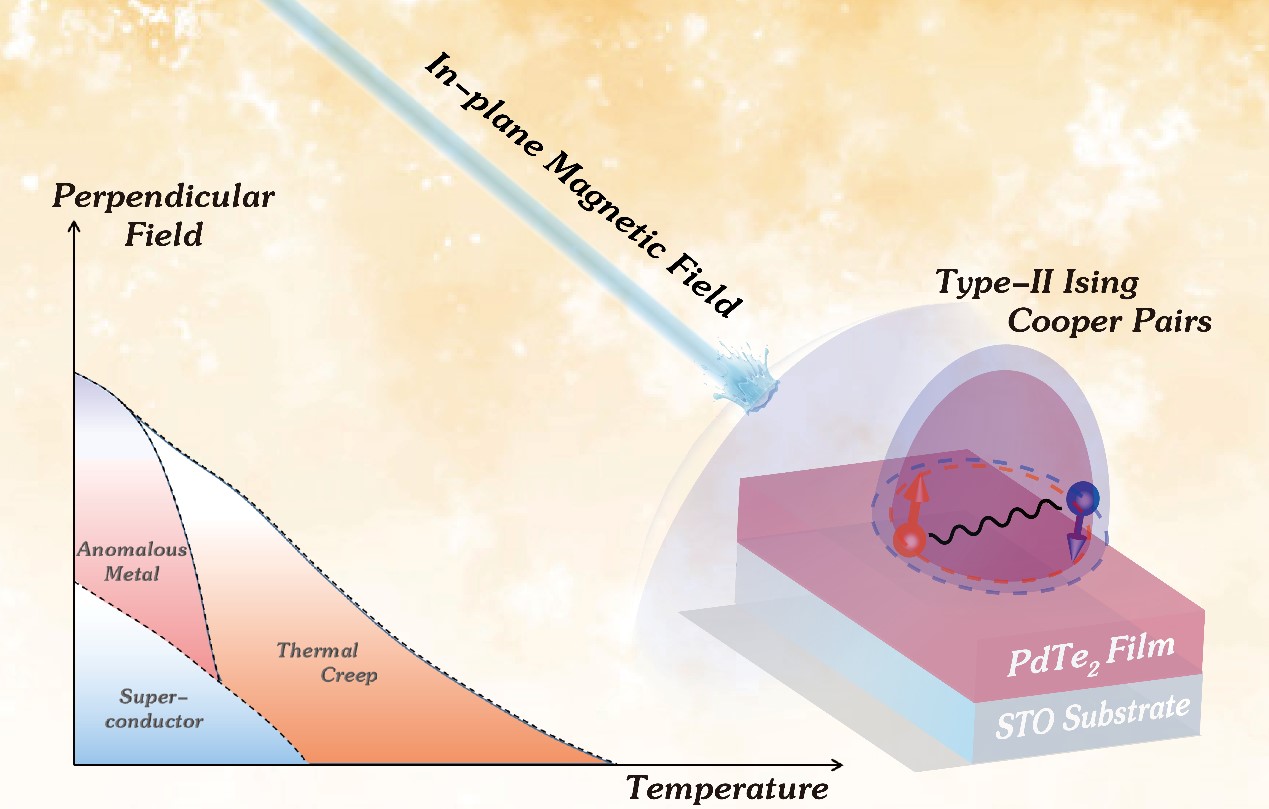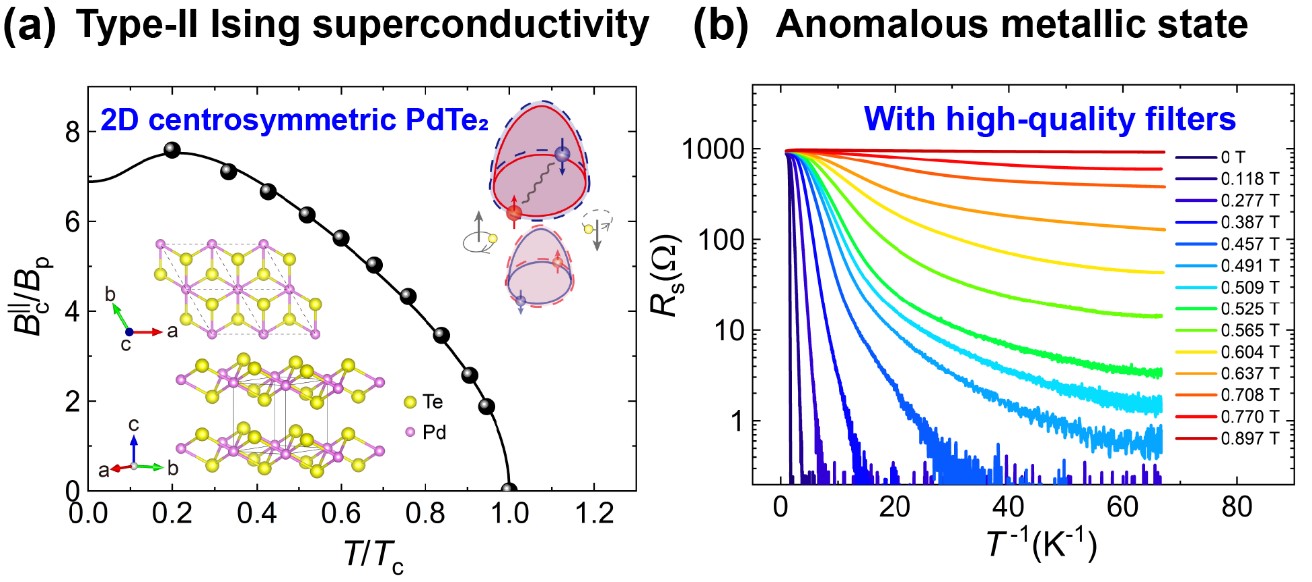Peking University, July 3, 2020: Two-dimensional (2D) crystalline superconductors are research frontiers of condensed matter physics and materials science. In 2016, Professor Iwasa at the University of Tokyo pointed out that quantum Griffiths singularity, anomalous metallic state and superconductivity surviving a large in-plane magnetic field (e.g. Ising superconductivity) are most important topics in the field of 2D crystalline superconductors (Nat. Rev. Mater. 2, 16094 (2016)). Ising superconductor is a kind of superconducting system with strong spin-orbit coupling (SOC). It is reported that in transition metal dichalcogenides, such as gated MoS2 and one monolayer (ML) NbSe2 flake, the broken in-plane inversion symmetry gives rise to Zeeman-type SOC, which polarizes the spins of the electrons to the out-of-plane direction and leads to a huge in-plane critical magnetic field much larger than Pauli limit. The Pauli limit is defined as the magnetic field required to destroy the Cooper pairs via the spin pair breaking effect in conventional superconductors. This special superconductivity with strong Zeeman-type SOC is called Ising superconductivity. Because of Zeeman-type SOC and spin polarizations, Ising superconductors exhibit large in-plane critical field up to several times of the Pauli limit, normally corresponding to dozens of Tesla. For the first time, Professor Wang Jian and collaborators reported the observation of Ising superconductivity in macro-size monolayer NbSe2 films grown by molecular beam epitaxy (MBE) (Nano Lett. 17, 6802 (2017)) and the interface induced Ising superconductivity in ultrathin crystalline Pb films (Phys. Rev. X 8, 021002 (2018)).

The detections of type-II Ising superconductivity and anomalous metallic state in two-dimensional crystalline superconductors
Moreover, the existence of 2D anomalous metallic state is one of major questions in condensed matter physics. The possible signature of anomalous metallic state has been reported experimentally in various 2D superconducting systems over the past thirty years (Rev. Mod. Phys. 91, 11002 (2019)). However, the emergence of anomalous metallic is still under intensive and wide debate due to the external high frequency noise in the measurements (Sci. Adv. 5, 3826 (2019)). By performing ultralow temperature transport measurement with high-quality filters, Professor Wang Jian and collaborators demonstrated the existence of anomalous metallic state in high temperature superconducting YBCO films with triangular array of holes (Science 366, 1505(2019)). However, the solid evidence of anomalous metallic state has not been reported in high-quality crystalline films grown by MBE.
Recently, Professor Wang Jian and Professor Lin Xi at Peking University, in collaboration with Professor Xue Qikun, Professor Wang Lili, Professor Xu Yong, Professor Yao Hong at Tsinghua University, and Professor Liu Haiwen at Beijing Normal University detected anomalous metallic state and a new kind of Ising superconductivity in 2D crystalline PdTe2 films grown by MBE. The systematic ultralow temperature transport measurement shows that 6-ML (around 3 nm) PdTe2 film exhibits a large in-plane critical field more than 7 times of the Pauli limit, which is the characteristic of Ising superconductivity. Different from the previously reported Ising superconductors, the PdTe2 film keeps the in-plane inversion symmetry, which indicates that there exists a new mechanism of Ising superconductivity (named type-II Ising superconductivity by Professor Wang Jian in discussion with Professor Xu Yong). Band structure calculation and theoretical analysis reveal that the 3-fold rotational symmetry in the PdTe2 films makes the effective magnetic field of SOC along the out-of-plane direction and leads to the out-of-plane spin polarization. The superconducting Cooper pairs formed by the electrons with out-of-plane spin polarization can survive under very large magnetic field parallel to the 2D system, which gives rise to the type-II Ising superconductivity with large in-plane critical field. Theoretical calculations indicate that for 2D superconducting systems with in-plane inversion symmetry, 4 and 6-fold rotational symmetry can also make the orientation of the effective SOC field to out-of-plane. Thus, the type-II Ising superconductivity can be generalized to various 2D systems with 3, 4 and 6-fold rotational symmetry. Therefore, the discovery of type-II Ising superconductivity is promising to stimulate a new research direction in the condensed matter physics.
Interestingly, under perpendicular magnetic field, the resistance of PdTe2 films drops and then saturates to a temperature-independent constant with decreasing temperature via ultralow temperature transport measurements with high-quality filters. It is the first solid experimental evidence of anomalous metallic states in high-quality 2D crystalline films grown by MBE, which further reveals that besides superconducting and insulating ground states, anomalous metallic state is another quantum ground state for 2D Bosonic systems. Moreover, most 2D superconducting systems are very sensitive to the atmosphere and easy to lose superconductivity. The superconductivity of PdTe2 films remains almost the same for more than 20 months without any protection layer. This macro-size ambient-stable superconducting system with strong SOC shows great potentials in superconducting electronic and spintronic applications.

Figure (a) The temperature dependence of in-plane critical fields of PdTe2 film, which is consistent with the theoretical formula of Ising superconductivity. The inset on the bottom left: the lattice structure of PdTe2, indicating that it is a centrosymmetric system, different from the previously reported Ising superconductors. The inset on the top right: the schematic of type-II Ising pairing. (b) The lgRS-1/T curves of PdTe2 film at different magnetic fields. The resistance drops and then saturates with decreasing temperature, which is the hallmark of anomalous metallic states. High quality filters are used in the measurements to well exclude the influence of high-frequency noise.
The paper was published online by Nano Letters on June 25, 2020. (DOI: 10.1021/acs.nanolett.0c01356). Full paper can be viewed here: https://pubs.acs.org/doi/full/10.1021/acs.nanolett.0c01356
Professor Wang Jian at Peking University, Professor Wang Lili at Tsinghua University and Professor Lin Xi at Peking University are corresponding authors of this paper. Dr. Liu Yi at Peking University, Professor Xu Yong at Tsinghua University, Sun Jian at Peking University and Dr. Liu Chong at Tsinghua University contributed equally to this work. Other collaborators include Professor Xue Qikun and Professor Yao Hong at Tsinghua University, Professor Liu Haiwen at Beijing Normal University etc.
This work was financially supported by the National Key Research and Development Program of China, the National Natural Science Foundation of China, the Strategic Priority Research Program of Chinese Academy of Sciences, the Beijing Natural Science Foundation, the Beijing Advanced Innovation Center for Future Chip and the China Postdoctoral Science Foundation.